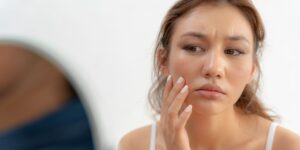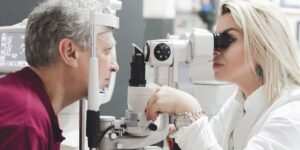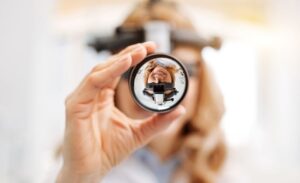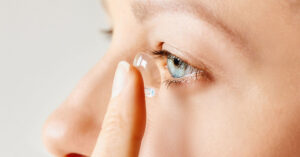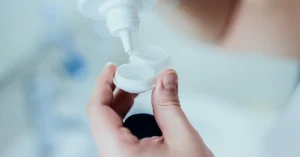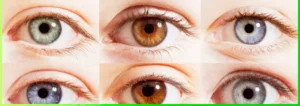Understanding Multifocal Contact Lenses
When it comes to vision correction, multifocal contact lenses offer a revolutionary solution for individuals with multiple vision problems. These lenses are designed to correct conditions such as nearsightedness, farsightedness, and presbyopia, allowing wearers to see clearly at various distances.
What are Multifocal Contact Lenses?
Multifocal contact lenses are specialized lenses that contain different zones for vision correction at different distances. Unlike traditional single-vision contact lenses, multifocal lenses provide clear vision for both near and far distances without the need for additional eyewear, such as reading glasses or bifocals. By incorporating multiple prescriptions into a single lens, multifocal contact lenses offer wearers the convenience of seamless vision correction for a range of visual impairments.
How Multifocal Contact Lenses Work
Multifocal contact lenses utilize different optical powers within the lens to correct vision at varying distances. The specific design of the lens depends on the type of multifocal lens chosen. There are two main types of multifocal contact lenses: simultaneous vision lenses and segmented vision lenses.
Simultaneous vision lenses have multiple prescriptions blended across the lens surface, allowing wearers to simultaneously focus on objects at different distances. This design provides a smooth transition between near and far vision. However, some wearers may experience decreased contrast sensitivity and visual disturbances due to the simultaneous correction of multiple prescriptions.
Segmented vision lenses, on the other hand, feature distinct zones for near and distant vision. These zones are separated by concentric rings or discrete areas within the lens. By directing the gaze through the appropriate zone, wearers can achieve clear vision at the desired distance. It may take some time for wearers to adapt to the different segments of the lens, but once the adjustment period is over, they can enjoy the benefits of clear vision at various distances.
Whether it’s simultaneous vision or segmented vision lenses, the brain learns to automatically adjust and switch between the different zones of the multifocal lens. This allows wearers to seamlessly transition between near and far vision, providing clear vision at all distances.
Multifocal contact lenses are available in both soft and rigid gas permeable (RGP) materials, allowing individuals to choose the option that best suits their needs and preferences. Soft lenses offer comfort and flexibility, while RGP lenses provide enhanced durability and visual acuity. Consult with an eye care professional to determine the most suitable material and design for your specific vision requirements.
Understanding the basics of multifocal contact lenses is the first step in exploring the benefits and considerations of these innovative vision correction solutions. By consulting with an eye care professional and considering factors such as your lifestyle, visual needs, and comfort preferences, you can find the right multifocal contact lenses to revolutionize your sight.
Types of Multifocal Contact Lenses
When it comes to multifocal contact lenses, there are two main types: simultaneous vision lenses and segmented vision lenses. Each type offers unique advantages and considerations, allowing individuals to find the best option for their vision needs.
Simultaneous Vision Lenses
Simultaneous vision lenses, also known as multifocal lenses, allow for both near and far vision correction at the same time. These lenses incorporate different power zones within a single lens, enabling individuals to see clearly at various distances without the need for switching glasses or contact lenses. However, it’s important to note that simultaneous vision lenses may come with some trade-offs.
While providing the convenience of a single lens for multiple distances, simultaneous vision lenses can cause decreased contrast sensitivity and visual disturbances for some individuals. The brain needs to adjust to the simultaneous focus points, and this adjustment period can vary from person to person. It’s important to consult with an eye care professional to determine if simultaneous vision lenses are suitable for your specific vision requirements and lifestyle.
Segmented Vision Lenses
Segmented vision lenses, also referred to as segmented multifocal lenses, offer clear vision at different distances by separating the power zones. These lenses have distinct areas or segments for near, intermediate, and distance vision. The wearer can shift their gaze to the specific segment corresponding to the desired focal point.
Segmented vision lenses function similarly to bifocal or trifocal eyeglass lenses. They provide a more distinct division between the different vision ranges, allowing for clearer and sharper focus. However, it may take some time for the wearer to adjust to the different segments and learn how to effectively shift their gaze between them.
When considering segmented vision lenses, it’s essential to consult with an eye care professional who can evaluate your visual needs and determine if this type of multifocal lens is suitable for you.
By understanding the different types of multifocal contact lenses, individuals can make an informed decision about which option aligns with their vision requirements and lifestyle. Whether you opt for simultaneous vision lenses or segmented vision lenses, it’s crucial to consult with an eye care professional to receive a comprehensive examination and prescription that caters to your unique needs.
Choosing the Right Multifocal Contact Lens
When it comes to selecting the right multifocal contact lens, there are several factors to consider. Each individual has unique vision needs; consulting with an eye care professional can help determine the most suitable option.
Factors to Consider
Prescription and Vision Needs:
The first step in choosing the right multifocal contact lens is understanding your prescription and vision needs. The prescription will determine the specific correction required for near-intermediate, and distance vision. It is important to know how to read your contact lens prescription to ensure accurate selection.
Lens Design:
Multifocal contact lenses come in different designs, including simultaneous vision lenses and segmented vision lenses. Simultaneous vision lenses have multiple prescription powers blended together, allowing wearers to see clearly at various distances. Segmented vision lenses have distinct zones for different prescriptions, offering clear vision at different distances. Consulting with an eye care professional will help determine which design suits your vision needs best.
Comfort and Fit:
Comfort and fit are essential for long-term wear. Multifocal contact lenses should fit well on the cornea and provide clear vision without discomfort. Factors such as lens diameter, base curve, and material should be considered to ensure a comfortable fit throughout the day.
Lifestyle and Activities:
Consider your lifestyle and daily activities when choosing multifocal contact lenses. If you engage in activities that require excellent near vision, such as reading or working on a computer, you may benefit from a lens design that prioritizes near vision clarity. On the other hand, if distance vision is crucial, such as for driving or outdoor activities, a lens design that emphasizes distance vision would be more suitable.
Eye Health and Moisture Content:
The health of your eyes and the moisture content in your eyes are important considerations. Some multifocal contact lenses are designed with specific materials that promote hydration and comfort. If you have dry eyes or other specific eye health concerns, discuss these with your eye care professional to find a lens that addresses your needs.
Consulting with an Eye Care Professional
Choosing the right multifocal contact lens can be complex, which is why it is crucial to consult with an eye care professional. They will assess your vision needs, examine your eyes, and recommend the most suitable multifocal contact lens based on your individual situation.
During the consultation, the eye care professional will consider factors such as your prescription, lifestyle, comfort preferences, and eye health. They will also take measurements to ensure a proper fit and provide guidance on lens insertion and removal techniques.
By working closely with an eye care professional, you can make an informed decision and find the multifocal contact lens that will provide clear vision and optimal comfort for your specific needs.
Remember, multifocal contact lenses are a remarkable innovation that can revolutionize your sight, providing clear vision at different distances for individuals with presbyopia or other vision impairments. However, the right lens choice depends on various factors, and professional guidance will help ensure the best outcome.
Benefits and Considerations of Multifocal Contact Lenses
When it comes to vision correction, multifocal contact lenses offer numerous benefits for individuals with presbyopia or those who require correction for multiple vision issues. Let’s explore the advantages and considerations of using multifocal contact lenses.
Clear Vision at All Distances
One of the primary benefits of multifocal contact lenses is their ability to provide clear vision at various distances. These lenses have different zones that allow for focused vision at near, intermediate, and far distances. By accommodating multiple vision needs, multifocal lenses offer convenience and eliminate the need for constantly switching between different pairs of glasses.
With multifocal lenses, wearers can enjoy seamless vision transitions, allowing them to see objects up close, read the text at a comfortable distance, and have a clear vision for activities requiring distance vision. This versatility makes multifocal contact lenses a popular choice for individuals seeking to reduce their dependence on glasses.
Adaptation Period and Brain Adjustment
Adapting to multifocal contact lenses may require an adjustment period. These lenses have different focal points within the same lens, and the brain needs time to learn how to automatically switch between these zones for optimal vision. During this adjustment period, wearers may experience slight blurriness or difficulty transitioning between distances. However, with consistent use, the brain learns to seamlessly adjust, resulting in clear vision at all distances.
It’s important to note that the adaptation period varies from person to person. Some individuals may adapt quickly, while others may require more time. It’s recommended to follow the guidance of an eye care professional and be patient during this adjustment phase. They can provide valuable tips and advice to help facilitate the adaptation process.
In addition to the benefits, it’s crucial to consider individual factors and consult with an eye care professional to ensure the suitability of multifocal contact lenses for your specific needs. Factors such as eye health, prescription requirements, and lifestyle considerations play a role in determining the most suitable type of multifocal lens for you. Regular check-ups with your eye care professional are essential to monitor the effectiveness and comfort of your multifocal lenses.
By understanding the benefits and considerations associated with multifocal contact lenses, you can make an informed decision about whether they are the right choice for your vision correction needs. The ability to achieve clear vision at all distances and the adaptability of the brain to adjust to different zones within the lens make multifocal contact lenses a popular and convenient option for individuals seeking versatile vision correction.
Comparing Multifocal and Monofocal Contact Lenses
When considering contact lenses, it’s essential to understand the differences between multifocal and monofocal lenses. Each type of lens offers unique advantages and considerations for individuals with different vision needs. Let’s explore the key differences between multifocal and monofocal contact lenses.
Multifocal vs. Monofocal Lenses
Monofocal lenses have a fixed focal point and provide clear vision at a specific distance, either for near, intermediate, or distance vision. They cannot adjust or accommodate different distances. For individuals who have a single vision correction need, such as myopia (nearsightedness) or hyperopia (farsightedness), monofocal lenses can be a suitable choice.
On the other hand, multifocal lenses are designed to provide vision at a range of distances. They correct both near, intermediate, and far distances, making them a popular option for individuals who want to reduce their dependency on glasses. Multifocal contact lenses have different zones or prescriptions within the lens, allowing for seamless transitions between distances. While multifocal lenses may require an adjustment period, they offer a convenient and natural option for people with multiple vision needs.
Low Light Vision and Contrast Sensitivity
When it comes to low-light vision, mono-focal lenses tend to offer better performance compared to multifocal lenses. Monofocal lenses have a single focal point, which can provide clearer vision in dimly lit environments. However, it’s important to note that individual experiences may vary.
Multifocal lenses, while offering the convenience of vision correction at various distances, may have a slight reduction in low-light vision compared to mono-focal lenses. Some individuals may notice a decrease in contrast sensitivity under certain lighting conditions. However, advancements in lens technology continue to improve the low-light performance of multifocal lenses, providing better options for individuals with varying lighting needs.
When choosing between multifocal and mono-focal lenses, it’s crucial to consider your specific vision requirements and lifestyle. Consulting with an eye care professional who can assess your vision needs and provide personalized recommendations is highly recommended. To learn more about how to read a contact lens prescription and other factors to consider when choosing contact lenses, visit our article on contact lens brands.
In the next section, we will explore the top multifocal contact lens brands, providing insights into some popular options available.
Top Multifocal Contact Lens Brands
When it comes to choosing multifocal contact lenses, several top brands offer high-quality options to meet your vision needs. These brands have gained recognition for their innovative designs, comfort, and clear vision capabilities. Two prominent multifocal contact lens brands are 1-Day Acuvue Moist Multifocal and other leading brands.
1-Day Acuvue Moist Multifocal
1-Day Acuvue Moist Multifocal contact lenses, manufactured by Johnson & Johnson, are widely regarded as one of the best multifocal lenses available. These lenses utilize a back-curve design that ensures proper centration on the eye, resulting in clear and sharp vision. The design also helps to maintain lens stability during eye movements, providing consistent visual performance.
One of the standout features of 1-Day Acuvue Moist Multifocal lenses is their excellent comfort. They incorporate Lacreon technology, which helps to lock in moisture, keeping your eyes hydrated throughout the day. This feature is particularly beneficial for individuals with dry or sensitive eyes.
These lenses are recommended for individuals with a visually demanding lifestyle and for those who are new to wearing contact lenses. They offer the convenience of daily disposable lenses, eliminating the need for cleaning and storage. For more information about the specific prescription requirements and suitability for your eyes, it is essential to consult with an eye care professional.
Other Leading Brands
In addition to 1-Day Acuvue Moist Multifocal, there are other leading brands that offer a range of multifocal contact lenses to cater to diverse vision needs. These brands include Alcon, CooperVision, and many more. Each brand offers its unique features and benefits, allowing individuals to find the right fit for their specific requirements.
When considering other leading brands, it’s important to consult with an eye care professional to determine the most suitable multifocal contact lens for you. The prescription and fitting process will ensure that the lenses align with your vision correction needs and provide optimal comfort.
To explore the full range of multifocal contact lens options from various leading brands, it is recommended to visit an eye care professional or specialized contact lens retailer. They can guide you through the selection process, taking into account factors such as your prescription, visual demands, and lifestyle. By choosing the right multifocal contact lens brand, you can revolutionize your sight and enjoy clear vision at all distances.
Cost of Multifocal Contact Lenses
When considering multifocal contact lenses, it’s important to be aware of the cost associated with these specialized lenses. The price of multifocal contact lenses can vary depending on several factors, including the brand, type, and prescription. Let’s explore the factors that can affect the cost and provide an average price range for multifocal contact lenses.
Factors Affecting Cost
The cost of multifocal contact lenses can be influenced by the following factors:
Brand:
Different contact lens brands offer a range of multifocal options, and the cost can vary based on the reputation, quality, and technology associated with each brand. Popular brands like Acuvue and CooperVision may have a higher price point compared to other brands.
Type:
Multifocal contact lenses are available in both soft and rigid gas permeable (RGP) materials, providing options for different preferences and needs. Soft lenses are generally more popular due to their flexibility and comfort, while RGP lenses offer sharper vision and better durability.
Prescription:
The complexity of your prescription can also impact the cost of multifocal contact lenses. Higher prescriptions or additional vision corrections, such as astigmatism, may require more specialized lenses, which can be reflected in the price.
Quantity:
Multifocal contact lenses are typically sold in boxes containing a specific number of lenses. The cost can increase based on the quantity of lenses needed for your desired supply.
Average Price Range
While multifocal contact lens prices can vary, having a general idea of the average price range is helpful. According to NVision Centers, multifocal contact lenses generally range from $50 to $150 per box. Keep in mind that this range is an estimate and the actual cost may vary based on the aforementioned factors.
It’s important to consult with an eye care professional to determine the most suitable multifocal contact lens option for your specific needs and prescription. They can guide the available brands, materials, and prices, allowing you to make an informed decision.
Remember to consider the long-term value of multifocal contact lenses. While the initial cost may be higher compared to other types of contact lenses, the convenience and benefits they offer, such as clear vision at all distances, can make them a worthwhile investment.
When exploring multifocal contact lenses, it’s essential to prioritize both your visual needs and your budget. By understanding the factors that affect the cost and having an average price range in mind, you can make an informed decision that aligns with your vision requirements and financial considerations.
Multifocal Contact Lenses for Presbyopia
Addressing Presbyopia
Multifocal contact lenses are specifically designed to address the vision needs of individuals with presbyopia, a common age-related condition that affects the ability to focus on objects up close. As we age, the natural lens of the eye becomes less flexible, leading to difficulty in seeing objects at close distances. This can result in the need for reading glasses or bifocals. Multifocal contact lenses provide a convenient alternative to correct both distance and near vision without the need for additional eyewear.
These lenses are designed with different zones that correct vision at various distances. They typically have a central zone for distance vision and one or more additional zones for near vision. The different power zones allow the wearer to see clearly at different distances, eliminating the need for separate glasses for reading or other close-up tasks. The specific design and power distribution of the lenses may vary depending on the brand and type of multifocal contact lens chosen.
Benefits for Presbyopic Individuals
Choosing multifocal contact lenses offers several benefits for individuals with presbyopia. Here are some advantages to consider:
Convenience:
Multifocal contact lenses provide a convenient and seamless solution for individuals who want clear vision at both near and far distances. They eliminate the need to switch between different pairs of glasses throughout the day.
Freedom of Movement:
With multifocal contact lenses, wearers can enjoy greater freedom of movement compared to traditional eyeglasses. They offer a wider field of view and allow for more natural eye movements, providing a more immersive and comfortable visual experience.
Enhanced Aesthetics:
Multifocal contact lenses offer a more aesthetically pleasing option for individuals who prefer not to wear eyeglasses. They provide a natural appearance, allowing wearers to maintain their preferred look without the need for visible eyewear.
Improved Adaptation:
While there may be an initial adaptation period for some wearers, many individuals find that their eyes quickly adjust to multifocal contact lenses. With consistent use, the brain adapts to the different power zones, allowing for seamless transitions between near and distance vision.
It’s important to consult with an eye care professional to determine if multifocal contact lenses are the right choice for your specific vision needs. They can assess your eye health, discuss your lifestyle requirements, and help you choose the most suitable multifocal contact lens option. For more information on reading contact lens prescriptions and other related topics, visit our article on how to read contact lens prescription.
Multifocal contact lenses provide a convenient and effective solution for individuals with presbyopia, allowing them to enjoy clear vision at various distances without the need for separate reading glasses or bifocals.
Multifocal Contact Lenses for Vision Correction
Multifocal contact lenses are a versatile option that can correct multiple vision issues in one lens. They are designed to address common visual impairments such as presbyopia and astigmatism, providing clear vision at various distances. Let’s explore how multifocal contact lenses can correct these vision problems.
Correcting Multiple Vision Issues
Multifocal contact lenses are specifically designed to accommodate different prescriptions in a single lens, allowing wearers to focus clearly on objects at various distances. For individuals with presbyopia, which is the gradual loss of near vision that often occurs with age, multifocal lenses offer a solution that eliminates the need for separate reading glasses. These lenses contain different zones that are specifically designed to focus on near and far distances, providing clear vision at different ranges. This feature is especially beneficial for those who require clear vision at different distances throughout the day.
Additionally, multifocal contact lenses can correct other common vision issues such as myopia (nearsightedness). By incorporating two or more prescriptions into a single lens, these lenses can provide clear vision for individuals with multiple visual impairments. Whether it’s near, intermediate, or distant vision, multifocal contact lenses can offer a comprehensive solution for individuals with various vision needs.
Astigmatism Correction
In addition to addressing presbyopia and other vision issues, multifocal contact lenses can also correct astigmatism. Astigmatism is a common condition characterized by an irregularly shaped cornea or lens, resulting in blurred or distorted vision. Multifocal contact lenses for astigmatism, also known as toric multifocal lenses, have been developed to provide clear vision for individuals with both astigmatism and presbyopia. These lenses offer three focal points: one for reading and up-close correction, one for intermediate vision, and one for distance. This allows individuals with astigmatism to enjoy the benefits of multifocal lenses while also correcting their astigmatic vision (Weston Contact Lens).
Choosing the right multifocal contact lens for vision correction depends on the specific needs and preferences of each individual. It is recommended to consult with an eye care professional who can assess your vision requirements and recommend the most suitable multifocal lens option. By addressing multiple vision issues with a single lens, multifocal contact lenses provide a convenient and effective solution for individuals seeking clear vision at different distances.
Multifocal Contact Lenses for Various Needs
When it comes to multifocal contact lenses, there are options available to suit various needs and lifestyles. Two important factors to consider when choosing multifocal contact lenses are lifestyle considerations and different material options.
Lifestyle Considerations
One of the advantages of multifocal contact lenses is their ability to accommodate multiple vision needs in a single lens, providing clear vision at different distances. This makes them a convenient option for people with active lifestyles who want to have clear vision without the hassle of switching between different pairs of glasses.
Whether you enjoy outdoor activities, sports, or simply lead a busy life, multifocal contact lenses can provide the vision correction you need without the need for additional eyewear. They offer a more natural and convenient option compared to carrying around multiple pairs of glasses or constantly switching between glasses and regular contact lenses.
It’s important to consult with an eye care professional to determine the most suitable multifocal contact lens for your specific lifestyle needs. They can help assess factors such as your visual requirements, daily activities, and any specific challenges you may face.
Different Material Options
Multifocal contact lenses are available in different materials, providing options to suit individual preferences and needs. The common material options include soft lenses, rigid gas permeable (RGP) lenses, and silicone hydrogel lenses.
Soft multifocal contact lenses are popular due to their comfort and ease of use. They are made of a flexible material that conforms to the shape of the eye, providing excellent comfort throughout the day. Soft lenses allow for high oxygen permeability, ensuring good eye health.
Rigid gas permeable (RGP) multifocal contact lenses are made of a durable and rigid material that provides excellent visual acuity. They offer crisp and clear vision, especially for individuals with astigmatism. RGP lenses can be a suitable choice for those who prefer a more precise vision correction.
Silicone hydrogel multifocal contact lenses combine the benefits of soft lenses with the enhanced oxygen permeability of silicone hydrogel materials. These lenses allow more oxygen to reach the cornea, promoting better eye health and increased comfort, especially for those who wear their lenses for extended periods.
The choice of material for multifocal contact lenses depends on factors such as comfort, visual acuity, and eye health. Your eye care professional can guide you in selecting the most appropriate material based on your individual needs and preferences.
By considering lifestyle factors and material options, you can find multifocal contact lenses that provide the vision correction you need while fitting seamlessly into your daily routine. It’s important to consult with an eye care professional to ensure you choose the right multifocal contact lenses for your unique needs and to ensure proper fitting and prescription accuracy.

